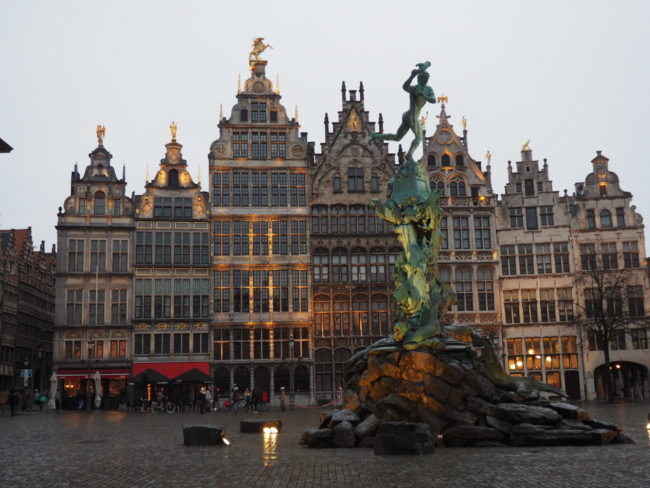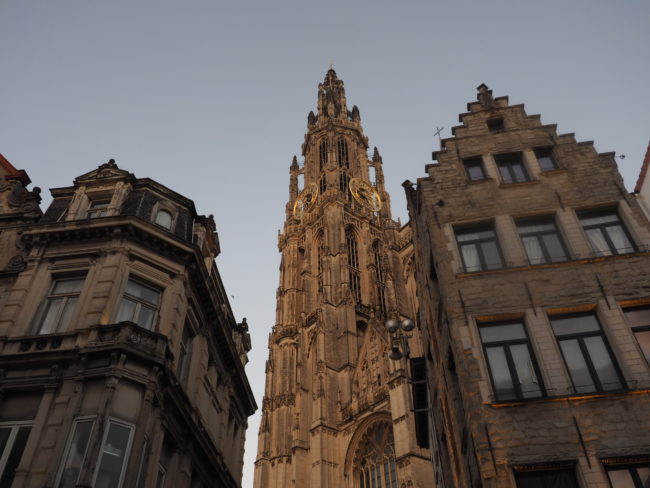When I’m asked about Antwerp, I always describe it as a hidden gem. A small and concentrated city, Antwerp is often overshadowed by its neighbours, Brussels and Bruges. Antwerp, however, has a lot to offer. It’s easy to lose yourself in small, secret courtyards and in vast museum corridors. It’s easy to realise that Antwerp is a crossroads for tradition and the unconventional. It’s easy to spend hours wandering the city, navigated only by the ubiquitous cathedral tower.
Much of Antwerp’s prominence and prosperity is based in the 16th and 17th centuries, which is echoed in the elaborate buildings found on the Grote Markt, or main square, and resounded throughout the confines of the city’s walls. One of the best restored and more accessible 16th-century buildings is Rubenshuis, the former home and studio of Flemish painter Peter Paul Rubens. Now a museum, it offers a snapshot into what it was like to live in Antwerp during its, arguably, most prominent time. A highlight of Rubenshuis is the courtyard, which comes unexpectedly at the end of the tour. In Antwerp, courtyards are quotidian, you just have to keep an eye out because they’re often hidden and easy to miss. Walk through that inconspicuous, windey alleyway – you never know where it might lead you in Antwerp.
Contrary to popular belief, French fries are not actually French. If you ask anyone in Antwerp, they’ll tell you exactly this: French fries are actually Belgian. An oft-repeated story goes that when American soldiers came to Belgium at the close of World War I, they mistakenly named the popular fried potato French fries after having tried them in Wallonia, the French-speaking region of Belgium. True or not, friets are a Belgian specialty, traditionally eaten with mayonnaise and ketchup. Frituur n°1 serves some of the best friets in the city – rumour has it they’re fried twice in horse fat.
An oft-repeated story goes that when American soldiers came to Belgium at the close of World War I, they mistakenly named the popular fried potato French fries after having tried them in Wallonia, the French-speaking region of Belgium
You can’t visit Antwerp without trying an authentic Belgian waffle. Luckily, these are easily found in small kiosks and street vendors throughout the city. In Belgium, there are two types of waffles: Brussels and Liege. The Liege waffle, the softer and doughier variety, is more popular in Antwerp and easily picked up. Another traditional Belgian street food is the oliebol, a fried dough ball topped with powdered sugar. Of course, the most famous Belgian sweet food is probably chocolate. Belgian chocolate is a household name, with many brands, like Godiva and Neuhaus, reaching international recognition. Luckily, Antwerp is home to independently owned chocolate stores – pop into Burie on Nationaalestraat to get a taste of authentic Belgian chocolate or Goossens Chocolatier, which is located outside of central Antwerp but well worth the trip, selling some of the best chocolate in the city.
The river Scheldt separates one side of Antwerp from the other half of the city. While there are a plethora of bridges connecting the two banks, the most unique way to get across is by using one of the underground tunnels, either on foot or by bike. Walking the Sint Anna Pedestrian Tunnel takes about 10 minutes. One of the most unique features is the original 1933 wooden escalator that brings visitors 31.57m underground, into the white and blue tiled tunnel. The other side of the tunnel is a perfect spot to watch the sunset, offering a stunning vista of the cityscape.
Nestled amongst the buildings of a low-rise city, composed mostly of 15th-century guild halls, medieval houses and post-World War I construction, are contemporary marvels. Driving into the city, Antwerp’s most modern structure is visible and was designed by the late Zaha Hadid. Built on top of an old firehouse, the ship-inspired building serves as Antwerp Port Authority and merges Antwerp’s established cultural heritage and its interest in moving towards ingenuity, as well as celebrating the naval culture that is so ingrained in the city’s history. Antwerp boasts the second largest port in Europe, and this rich maritime culture is explored and celebrated in the Museum aan de Stroom (Mas). While the collection at the Mas is impressive and offers a look into an important aspect of Antwerp’s history, more significantly, the building is prominent on Antwerp’s skyline and provides a striking contrast against the Gothic Onze-Lieve-Vrouwekathedraal that dominates the landscape.

Today, Antwerp is widely considered a fashion capital. Boasting the impressive “Antwerp Six” – six Antwerp-based designers who graduated from the Royal Academy of Fine Arts in the early 1980s – the city’s interest in fashion is visible in the countless independently owned boutiques located in Central Antwerp. The Modemuseum, located on one of the most famous shopping streets in the city, Nationalestraat, is surprisingly hard to locate and blends in alongside the neighbouring shops. Walk into any boutique in this area and get a taste of true Antwerp fashion.
On a Sunday, when most of the shops and restaurants are closed – one of the more traditional aspects of Antwerp – a small area around Kloosterstraat stays open. The city tends to be a bit quieter on a Sunday, and this is the perfect opportunity to explore the antique shops and independently owned boutiques that line the cobbled streets. With antique stores lining the streets, spend an afternoon perusing vintage postcards of Antwerp, piles of forgotten books in Koetshuis or refurbished furniture in Woodstock. You never know what you might find.
Belgium, of course, is known for its strong and varied options when it comes to beer. The traditional Antwerp beer is De Konick, or if you’re ordering in Flemish, een bolleke, alsjeblief. The Pelgrom is an underground cave-turned-bar, lit by candlelight and feels wonderfully medieval. While the bar itself is relatively well known, the 500-year-old building also houses the smallest museum in the city, de Poorterswooning. A visit to the Pelgrom and its museum are like taking a step into medieval Antwerp. The 30-minute tour is the perfect prelude to a beer in the Pelgrom. Perhaps somewhat lesser-known, Antwerp is famous for jenever, or Dutch gin. Just around the corner from the Pelgrom you’ll find De Vagant, a jenever bar, which boasts over 200 flavours of gin.
The legend goes that when someone wanted to cross the river to visit Antwerp, they had to pay a fee to a giant who guarded the passageway. If they refused to pay, the giant would cut off their hand and throw it into the river Scheldt
While in the winter months, when the temperature can drop into the negatives, bars like the Pelgrom and De Vagant are the perfect setting for drinks, long summer days spent sitting in Antwerp’s squares is an experience in itself. During the summer months, a concert takes place in Onze-Lieve-Vrouwekathedraal from about 8pm on Monday evenings that is audible in nearby squares and restaurants. It stays light until about 11pm, providing a chance to appreciate the long summer evenings and comfortable temperature. The cafes are full with locals and tourists alike looking out onto the squares, people-watching, enjoying the free concert and sipping on a bolleke.
Walk onto the Grote Markt, and you’ll see tourists posing on a rocky statue, the top of which is decorated with a chiseled figure throwing a hand. The legend goes that when someone wanted to cross the river to visit Antwerp, they had to pay a fee to a giant who guarded the passageway. If they refused to pay, the giant would cut off their hand and throw it into the river Scheldt. One day, in protest, a Roman soldier, Silvius Brabo, cut off the giant’s hand and threw it into the river. As a result, the hand has become a symbol of Antwerp. Antwerpse handjes are a traditional Antwerp butter cookie in the shape of this famous hand. Most bakeries and chocolatiers offer a variation of the biscuit. My favourite bakery, one I’ve been going to since I can remember, is Bakkerij Goossens. The small bakery, with the original storefront, almost always has lines out the door. The interior itself only fits about four customers at a time. This is one instance where Antwerp is rooted in tradition.
When you visit Antwerp, I hope you see what I see. I hope you see a city doused with tradition but open to change and innovation. I hope you see a city that celebrates its rich history and culture. I hope you realize that Antwerp is a hidden gem that might not stay hidden for much longer.







